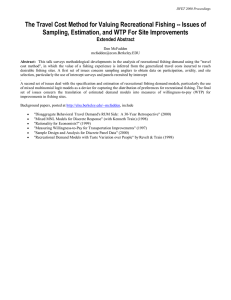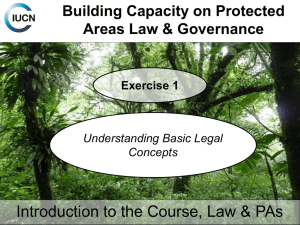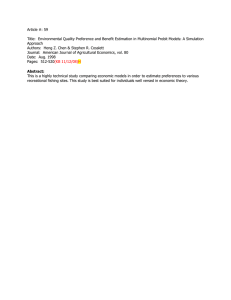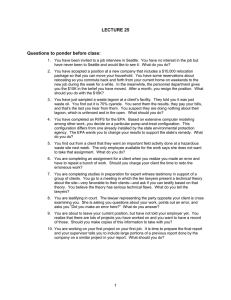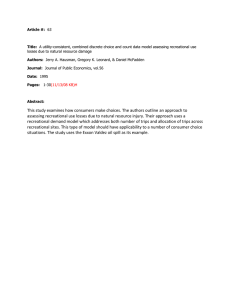Recreation Management in Venice Lagoon
advertisement
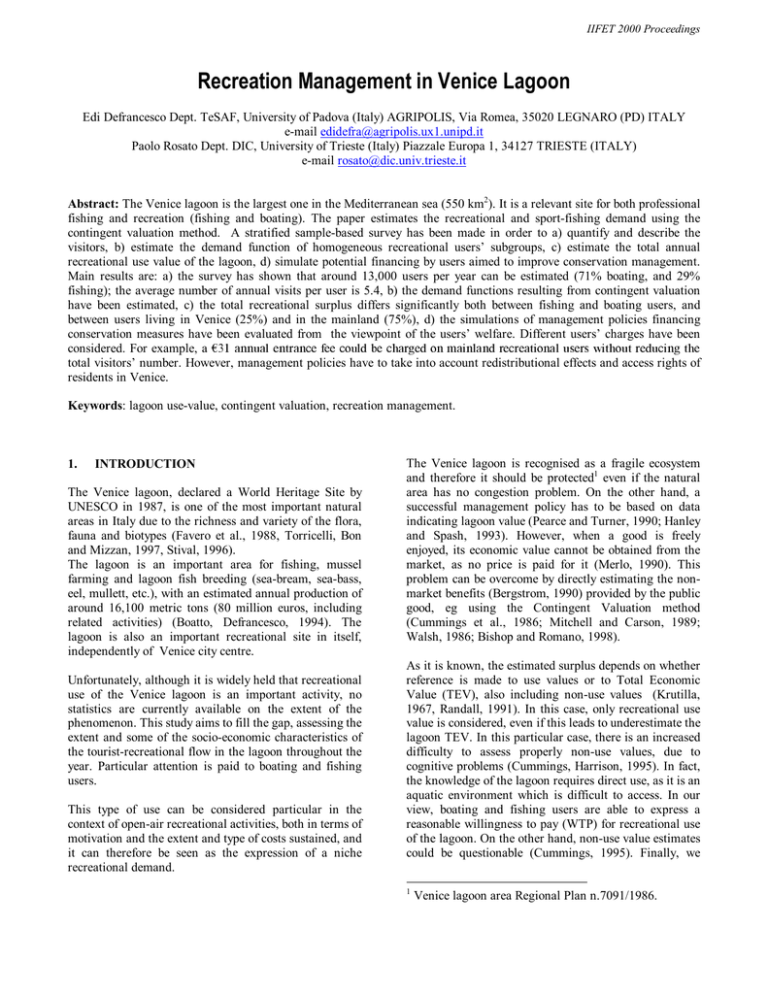
IIFET 2000 Proceedings Recreation Management in Venice Lagoon Edi Defrancesco Dept. TeSAF, University of Padova (Italy) AGRIPOLIS, Via Romea, 35020 LEGNARO (PD) ITALY e-mail edidefra@agripolis.ux1.unipd.it Paolo Rosato Dept. DIC, University of Trieste (Italy) Piazzale Europa 1, 34127 TRIESTE (ITALY) e-mail rosato@dic.univ.trieste.it Abstract: The Venice lagoon is the largest one in the Mediterranean sea (550 km2). It is a relevant site for both professional fishing and recreation (fishing and boating). The paper estimates the recreational and sport-fishing demand using the contingent valuation method. A stratified sample-based survey has been made in order to a) quantify and describe the visitors, b) estimate the demand function of homogeneous recreational users’ subgroups, c) estimate the total annual recreational use value of the lagoon, d) simulate potential financing by users aimed to improve conservation management. Main results are: a) the survey has shown that around 13,000 users per year can be estimated (71% boating, and 29% fishing); the average number of annual visits per user is 5.4, b) the demand functions resulting from contingent valuation have been estimated, c) the total recreational surplus differs significantly both between fishing and boating users, and between users living in Venice (25%) and in the mainland (75%), d) the simulations of management policies financing conservation measures have been evaluated from the viewpoint of the users’ welfare. Different users’ charges have been considered. For example, a ¼ DQQXDO HQWUDQFH IHH FRXOG EH FKDUJHG RQ PDLQODQG UHFUHDWLRQDO XVHUV ZLWKRXW UHGXFLQJ WKH total visitors’ number. However, management policies have to take into account redistributional effects and access rights of residents in Venice. Keywords: lagoon use-value, contingent valuation, recreation management. 1. INTRODUCTION The Venice lagoon, declared a World Heritage Site by UNESCO in 1987, is one of the most important natural areas in Italy due to the richness and variety of the flora, fauna and biotypes (Favero et al., 1988, Torricelli, Bon and Mizzan, 1997, Stival, 1996). The lagoon is an important area for fishing, mussel farming and lagoon fish breeding (sea-bream, sea-bass, eel, mullett, etc.), with an estimated annual production of around 16,100 metric tons (80 million euros, including related activities) (Boatto, Defrancesco, 1994). The lagoon is also an important recreational site in itself, independently of Venice city centre. Unfortunately, although it is widely held that recreational use of the Venice lagoon is an important activity, no statistics are currently available on the extent of the phenomenon. This study aims to fill the gap, assessing the extent and some of the socio-economic characteristics of the tourist-recreational flow in the lagoon throughout the year. Particular attention is paid to boating and fishing users. This type of use can be considered particular in the context of open-air recreational activities, both in terms of motivation and the extent and type of costs sustained, and it can therefore be seen as the expression of a niche recreational demand. The Venice lagoon is recognised as a fragile ecosystem and therefore it should be protected1 even if the natural area has no congestion problem. On the other hand, a successful management policy has to be based on data indicating lagoon value (Pearce and Turner, 1990; Hanley and Spash, 1993). However, when a good is freely enjoyed, its economic value cannot be obtained from the market, as no price is paid for it (Merlo, 1990). This problem can be overcome by directly estimating the nonmarket benefits (Bergstrom, 1990) provided by the public good, eg using the Contingent Valuation method (Cummings et al., 1986; Mitchell and Carson, 1989; Walsh, 1986; Bishop and Romano, 1998). As it is known, the estimated surplus depends on whether reference is made to use values or to Total Economic Value (TEV), also including non-use values (Krutilla, 1967, Randall, 1991). In this case, only recreational use value is considered, even if this leads to underestimate the lagoon TEV. In this particular case, there is an increased difficulty to assess properly non-use values, due to cognitive problems (Cummings, Harrison, 1995). In fact, the knowledge of the lagoon requires direct use, as it is an aquatic environment which is difficult to access. In our view, boating and fishing users are able to express a reasonable willingness to pay (WTP) for recreational use of the lagoon. On the other hand, non-use value estimates could be questionable (Cummings, 1995). Finally, we 1 Venice lagoon area Regional Plan n.7091/1986. IIFET 2000 Proceedings must ensure coherence with the aims of the study: if the objective is to propose measures for recreational use regulation, the assessment must obviously refer to the related demand. In this paper, we estimate the recreation demand functions and the users’ surplus. Finally, we simulate the visitors’ welfare effects in applying different user annual charges, aimed to finance lagoon protection on the basis of the subsidiarity principle by which environmental policies appear to be increasingly inspired. These effects are assessed both from the point of view of the public agency receiving the payments and in terms of users’ welfare. 2. SURVEY METHOD The research develops through the following steps: a) Identification of the facilities offering access services to the lagoon assuming the official data available: 45 firms have been identified, 31 of which are distributed around the edge of the lagoon and 14 in the city of Venice and on the islands. b) Representative sample survey of marinas (JanuaryMarch 1999) involving some of the most important ones (77% of the total). The survey, carried out through a questionnaire interviews, enables us: a) to estimate the total number of recreational users and their distribution throughout the year, b) to stratify the users by boat value and type of recreational use (boating and fishing). These estimates cover more than 90 percent of the overall annual recreational use. c) Identification of a stratified random sample of five marinas and sample design for the survey of direct users (Contingent Valuation). On the basis of users distribution over time, which peaks during weekends, 15 days have been randomly selected during weekends from May to September. A pre-survey for fine-tuning of the questionnaire suggests that the best time for carrying out the interviews is when people are going to leave for their trip. The sampling design adopted provides interviews of all the users met at the tourist marinas in the sample days. Therefore it, does not allow a priori stratification of the respondents. The extension of the sample results to the entire population has been performed on the basis of the stratified total number of users, estimated in the stage b) of the survey. d) Interview. The first part of the questionnaire aims to characterise the users from the socio-economic point of view. The second part is concerned with the Contingent Valuation, performed by simulating a hypothetical market aimed at eliciting the annual individual WTP for the recreational activities in the lagoon. The proposed hypothetical scenario envisages WTP for an annual fishing licence in the lagoon for anglers or for an annual site-specific access permit for boating users. The method of the bidding game or iterative procedure has been used with three different starting points, 50, 100 and 150 selected randomly, to minimise the mean distortion effect (Boyle et al., 1985)2. ¼ UHVSHFWLYHO\ The data analysis is organised as follows: a) Socio-economic description recreational users. of the sample of b) Stratification of the sample into homogeneous subgroups: fishing and boating users; residents in Venice historical centre and in the mainland; income level (using the boat-value as a proxi3). This enables us to assess mean individual WTP in every subgroup in order to obtain a better estimate of total WTP. c) Estimate of the recreational demand function of the lagoon expressed by each users’ subgroup (Venetians and non-Venetians, boating and fishing users) and of the annual surplus4. In general, the recreational demand function of a non-rival public good is: WTPi = f(Ni ) (1) where: WTPi = a given level of WTP, Ni = the number of users with WTP greater than or equal to WTPi . In this case, a semilogarithmic linear function, widely used in literature, has been adopted: Pi = a + b ln(WTPi ) (2) where Pi represents the back-cumulated percentage of the users, corresponding to a given level of willingness to pay WTPi . 2 No statistically significant correlation emerges between the value declared and the starting point. 3 Particular attention has been paid to estimation of the boat value, taken as an indicator of the owner-user’s income. WTP is often correlated with the respondent’s income, which is in fact difficult to measure directly because of answer refusals. 4 The double stratification has been performed in order to cross-check the robustness of the resulting annual users’ surplus estimates. As it will be highlighted later, the difference between the two estimated surpluses is small (78,300 ¼ RI WKH PHDQ WRWDO 2 IIFET 2000 Proceedings Compared to (1), function (2) refers to recreational users’ percentages (Pi ) and not to frequencies (Ni ). This allows estimation of the demand function on sample data and subsequent extension to the total users’ population N : N f(WTPi ) large boats have been interviewed. Their individual annual WTP has been estimated using regression analysis, as it will be discussed later. (3) The total users’ surplus has been obtained by integrating the function on the entire domain. 3. THE USERS The survey carried out at the marinas enables us to estimate 13,235 annual recreational users, of which 5,565 are resident in Venice and have special permits5. The number of annual trips per user is on average 5.4. The boats used for visits to the lagoon are mainly small motorboats (79% of the boats are less than 7 metres long). In spring, users go out mainly for fishing, with a growing number of pleasure trippers as the summer approaches. Given the sampling technique adopted, the sample distribution by boat value (Table 3) differs from the entire population one, because the percentage of small boat users is overestimated and no anglers with medium5 People leaving in Venice have mooring rights at specific points on the canal banks in the city centre. This right allows direct access to the lagoon. 6 Using occupation to measure income would have involved the exogenous attribution of a mean income to each of them, taken from official statistics, and this would have produced less reliable results. Mean No. cases V d 10 41.84 168 11.31 11 – 25 44.53 113 10.18 26 – 50 46.47 17 10.14 t51 56.33 3 7.51 Total 43.26 301 10.94 Table 1. Average age of respondents by boat value (000¼ Job Boating Fishing Total Artisan 15.1 24.6 17.3 Entrepreneur 11.2 5.8 10.0 Professional 16.4 8.7 14.6 Tradesman 11.2 13.0 11.6 Factory worker 8.2 11.6 9.0 Office worker 22.0 18.8 17.9 Teacher 4.3 / 3.3 Student 3.9 2.9 3.7 Executive 1.7 1.4 1.7 Pensioner 4.3 11.6 6.0 Housewife 1.7 1.4 1.7 Total 100.0 100.0 100.0 Table 2. Occupation by lagoon recreational use (%) 301 people have been interviewed, mainly pleasure trippers (71.1%). The age of the respondents is between 17 and 72, with an average around 43. 55.3 percent of cases are in the 35-50 age-group. There are significant differences in the mean age of users grouped according to the boat value (D=5%) (Table 1). As the level of income generally increases with age, at least until retirement, the close correlation between age and boat value, confirms that the value of the boat is a good income indicator, better than the owner’s occupation6. The mean anglers’ age is higher, although not to a statistically significant extent, than that of pleasure trippers (45 and 42 respectively). Regarding type of occupation, over 50 percent of the users are self-employed, 21.2 percent clerical workers, 9 percent factory workers and 6 percent retired (Table 2). The distribution by type of employment does not significantly differ between fishing and boating users, although there is a higher percentage of retired, factory workers and artisans among the former. Boat value Boat value (000¼ Boating Fishing Total 54.7 59.4 55.8 d 20 21 – 50 37.1 39.1 37.5 51 – 100 7.3 / 5.6 0.9 1.5 1.1 t 101 Total 100.0 100.0 100.0 Table 3. Boat value by lagoon recreational use (%) The residents in the mainland use boats with a significantly higher mean value (D=5%) (13,750¼ WKDQ those of residents in Venice (10,400¼ 7KLV LV GXH WR WKH structural limits of the mooring facilities in Venice, while differences in income do not appear to be relevant. 4. THE ANNUAL INDIVIDUAL WILLIGNESS TO PAY Although all the respondents show great satisfaction from their trips into the lagoon, 78 cases do not reveal their WTP. The majority of them believes that environmental protection of the lagoon should be financed by: a) general taxation (51.3%), b) already-paid fishing licences (9%), 3 IIFET 2000 Proceedings or c) polluting industrial activities in the lagoon edge (16.7%). Another point of view expressed is refusal to pay for an environmental resource considered as a public good, the free use of which is considered an inalienable right (3%). This justification, as expected, is expressed mainly by users living in Venice city centre (19%). None of these justifications are connected with income problems or lack of appreciation of the lagoon. The refusals to answer have been considered strategic, indicating, in other words, free-riding behaviours, rather than an appreciation located at the break-even point between cost sustained for the recreational use and its marginal utility7. These cases have been excluded from the estimation of the mean WTP. Overall, the mean individual annual WTP is equal to 94.7¼ 7DEOH Mean 94.7 Confidence interval of the mean (95%) Lower limit 87.3 Upper limit 102.1 Median 125.0 Std. deviation 55.8 Minimum 25.0 Maximum 250.0 Interquartile range 75.0 Table 4. Individual annual willingness to pay (¼ The analysis of the sources of individual WTP variability (Table 5) shows that: Total User’s age d 20 20 – 40 40 - 60 u 60 Boat value (000¼ d 10 11 – 25 26 – 50 t 51 Boating Fishing Trips out per year d3 4–6 7–9 t9 The WTP increases with age up to 60 and then drops. This is linked to income conditions which improve up to retirement age. The differences in mean WTP of the respondents belonging to different age groups are fairly significant, also at statistical level (D=9%). b) The boat value, taken as an indicator of income, is correlated with the mean WTP declared by the respondents. A statistically significant difference (D<5%) in the WTP of the different boat value subgroups emerges. c) 7 The aim of the trip significantly affects the mean WTP. Pleasure trippers have a higher mean WTP than anglers. This statistically significant difference (D=5%) is linked to the already paid non site-specific fishing licence. The annual cost of licence (22¼ LV almost exactly equal to the mean difference in WTP between the two groups of users. This hypothesis is indirectly confirmed by an application of travel cost method on the same sample (Defrancesco and Rosato, 2000). N 223 55.8 37.5 90.0 102.1 72.8 2 98 123 11 17.7 52.3 54.6 45.4 85.3 104.1 119.6 116.7 85 12 3 55.5 52.3 76.4 98.7 80.3 175 48 56.3 52.1 63.6 90.4 108.7 107.8 33 87 57 46 30.7 49.8 68.5 54.4 Venice city centre 105.4 56 62.0 Mainland 91.2 167 53.3 Table 5. Mean individual annual willingness to pay (¼ d) The mean individual annual WTP differs significantly (D<1%) according to the total number of trips per year declared by the respondents. It increases up to nine trips and then levels. e) a) V Mean 94.7 5. The mean WTP expressed by residents in Venice city centre is higher than that of the mainland residents, indicating greater appreciation of the lagoon area resulting from their familiarity with it. The WTP declared by Venetians shows a greater variability than that of the other respondents: a significant number of residents consider free access to the lagoon as an inalienable right. TOTAL WILLIGNESS TO PAY Extension of the individual mean sample WTPs8 to the population has been performed according to the weight of every users’ subgroup in the population, estimated in the preliminary survey on the tourist marinas (Table 6). 8 The lack of sample data for the highest boat value of the Venetians’ group, due to the sampling technique adopted, has been filled by estimating the mean WTP value via a simple linear regression model using boat value as independent variable. The regression has been very satisfying (R2=0.99) and the coefficients are statistically different from zero. 4 IIFET 2000 Proceedings Boat value 26-50 1144 t 51 d 10 Venice city 1789 358 centre Mainland 1520 3283 973 304 6080 Table 6. Total recreational users by boat value (000¼ DQG residence; 11-25 3864 Total 7155 The estimated total annual users’ surplus is around 1.46 million euros, corresponding to the annual recreational use value of the Venice lagoon (Table 7) for boating and fishing. 59 percent of the total surplus is provided for residents in Venice city centre. The confidence interval of the estimate ranges from 467,600 to 757,000¼ LQ WKH FDVH of mainland residents and from 684,000 to 1,040,600¼ IRU residents in the city centre. Lower limit* Venice Upper limit* Boat value (000¼ 11-25 26-50 t 51 d 10 130.4 361.3 133.9 58.4 174.9 443.5 171.6 72.3 219.3 525.7 209.4 86.2 Lower limit* 107.6 281.6 Mainland 122.7 329.4 Upper limit* 137.8 377.3 78.4 113.7 149.0 0 35.5 93.2 RECREATIONAL SIMULATION USERS’ The simulation of the effects of this policy requires the estimation of the aggregate demand functions of the different types of recreational users. The estimated semilogaritmic functions (Table 8) closely fit the data; the coefficients are all significantly different from zero (D<1%) and statistically different from each other. R2 Boating Fishing Total 684.0 862.3 1040.6 a) The high recreational value expressed the lagoon users and the significant differences among individual WTP according to use and residence, provide a useful starting point for conservation policies assessment: a) on the one hand, it is useful to know the maximum value that the public agency can rationally allocate to protection operations, from the users’ point of view; b) on the other, it is important to know the different users’ appreciation in order to fine-tune annual charges to be applied. 9 Examples of payment systems for recreational services produced by public goods are: mushroom picking permits in several alpine areas, car entry tolls to congested areas of outstanding natural beauty, entry fees to historical towns (the so-called ‘Jubilee pilgrim tax’). B WTP (¼ Min Max 0.95 2.78 -0.508 33.1 0.86 2.74 -0.516 29.5 236.6 204.5 The most significant differences among the estimated recreational demand functions are: CHARGE Some examples of annual charges for the lagoon recreational use are presented below, discussing their implications from the viewpoint of both agency applying the fees and the users’ welfare9. The assessments are performed under the reasonable assumption that at present there is no congestion in the lagoon. Therefore the a Venice 0.94 2.70 -0.482 33.8 268.6 centre Mainland 0.95 2.74 -0.504 31.3 227.7 Table 8. The estimated demand functions 467.6 601.3 757.3 Total 297.6 772.9 285.3 107.8 1463.6 Table 7. Total annual recreational users’ surplus (000¼ * Confidence interval of the mean (D=5%) 6. reduction in the number of recreational users due to an entry fee could not increase the individual surplus of those who, paying the charge, make their trips in a less crowded environment. It is assumed, moreover, that the public agency would operate as a monopolist being free to choose the most appropriate fee. According to the assumption about strategic answers, the functions highlight a minimum WTP above zero. Thus, all the present recreational users gain a surplus from the lagoon. A minimum WTP above zero is empirically confirmed by the basically stable distribution of the back-cumulated frequencies of the respondents where the WTP is just above the minimum. Theoretically, this can be justified by high fixed annual costs connected with the boat, ie, sunk costs. This has important implications for the charge policy. In fact, the annual WTP corresponding to 100% users’ frequency (WTP Min in Table 8) pinpoints the annual charge that would not exclude any of the present users. On average, this value is 32¼ per year, it is lower for anglers, already paying for a non site-specific fishing licence, and slightly higher in the case of Venetians as they use the lagoon more intensely. b) Significant differences are shown also in the annual WTP at which all users would give up the lagoon (WTP Max in Table 8). An average annual value of 237¼ ZRXOG H[FOXGH DOO SUHVHQW XVHUV 7KLV PD[LPXP WTP is lower for anglers than pleasure trippers and higher in the case of Venetians. This is due to an income effect for anglers and to an higher recreational use value for Venetians. 5 IIFET 2000 Proceedings c) The mean recreational elasticity of demand is lower in the case of residents in Venice city centre with respect to those living on the mainland. On the other hands, the boating and fishing users show a similar elasticity. loss is equal to the area OACWTPmin and the net users’ surplus is WTPminCWTPmax; there is no reduction in the total social welfare because of the application of fee 11. c) N. Users Boating Fishing Min 10588 349.9 2647 78.0 Total Integral Surplus 745.0 161.2 Total 1094.8 239.1 1333.9 Venice city centre 7155 241.4 567.0 810.0 Mainland 6080 190.4 411.4 601.7 Total 1412.2 Overall 13235 425.3 441.3 1307.9 Table 9. Total annual recreational surplus for the entire users’ population (000¼ d) The recreational users’ surplus estimates obtained by integrating the demand functions10 are similar to those obtained by extrapolation of the mean values (Table 9). In order to clearly understand the recreational users’ welfare effects of different charges policies, we can refer to the Marshallian demand function for each homogeneous users’ subgroup (Figure 1): a) When the access to the lagoon is free of charge, the total annual recreational users’ surplus is the area OACWTPmax. b) If an annual charge equal to WTPmin is applied, the total number of overall users does not change and a portion of the annual users’ surplus is transferred to the public agency, for an overall value equal to the sum of the permits paid; the transferred users’ surplus 10 The surplus has been obtained as follows: NWTPmin+N³ a+bln(WTP) dWTP (4) where the integral is calculated between EXP((1-a)/b) and EXP(-a/b). The value of the first addend is given in the table as Min surplus and expresses the revenue obtained by applying the minimum charge which does not exclude any of the present users: for example, by differentiating the charge according to whether users are pleasure trippers or anglers, the public agency would collect an overall revenue of 350,000¼ SHU \HDU IURP WKH IRUPHU DQG 78,000¼ IURP WKH ODWWHU $Q LQFUHDVLQJ FKDUJH ZLOO gradually exclude present users and it will cause an increasing recreational users’ surplus loss, reducing the Integral Surplus column in Table 9. The latter, added to the Minimum surplus, is equal to the Total annual surplus of the recreational users. If the annual site-specific charge is higher than WTPmin , for example T, the users willing to pay the licence are OB, while the others (AB) will be excluded from lagoon recreation. The revenue accruing to the public agency is OBDT, the net surplus of the fee-paying users is reduced to TDWTPmax, while the benefit loss of the users excluded is BACD, a social welfare loss not transferred to anyone else. If the public agency behaves as a monopolist, it will set the annual entrance fee in order to maximise its revenue OBDT12, regardless of any considerations concerning the number of people excluded and the social surplus loss BACD. On the other hands, if the agency takes into account social welfare effects, it will set the charge at a lower compromise level. These welfare effects do not take into account the impacts on related sectors. However, such a policy, should be evaluated taking into account not only the welfare loss of the present users (direct effects) but also the effect induced on related activities by the exclusion of some users, eg. employment and income of the tourist marinas, of the firms selling fishing equipment, etc.. The payment system for access to the lagoon has been simulated assuming that the public agency can decide to differentiate the annual charges between residents in Venice and those in the mainland. Despite of the higher individual WTP of Venetians, a lower annual charge could be applied for them, because of their historically based perception of a free access right to the lagoon. Obviously, these simulations must be regarded only as an example of how surplus estimates should support decision-making process of the public agency for the Venice lagoon management. The first simulation has been performed assuming a minimum charge of 31.3¼ IRU PDLQODQG UHVLGHQWV DQG leaving residents in Venice city centre free right of access (hypothesis A). In this case the agency would receive only 190,500¼ SHU \HDU FRPLQJ IURP WKH UHFUHDWLRQDO VXUSOXV of residents on the mainland. The number of users would 11 In this case the transaction costs can be considered negligible in marginal terms, given that the administrative structures that could collect the payments are already operating. 12 In the case of a semilogarithmic recreational demand function, the charge maximising the public agency revenue can be obtained by: max T(N(a+bln(T))), or T=exp(-(a+b)/b) (5). 6 IIFET 2000 Proceedings not vary and therefore the charges policy would not provide any social welfare loss. This fee policy highly differentiates the right to access the lagoon in favour of city centre residents. Also hypothesis B would not bring any reduction of users even extending the minimum charge to city centre residents. In this case the authority would not recognise any free right of access. This would transfer 432,000¼ RI users’ recreational surplus to the agency, 241,500 of which come from the residents in Venice city centre. Again, there would be no social welfare loss, but a simple transfer of surplus from the users to the agency. The revenue of the public agency is equal to 72.2 percent of the maximum amount that could collect the management agency acting as a monopolist. WTP WTPmax C WTPmin O B Trade-off analysis between D and E hypotheses suggests that a charge above the minimum for residents in Venice city centre could be politically questionable. This option increases agency’s revenue by only 13,500¼ SHU \HDU EXW Venetians may refuse limitations of access to the lagoon, which has always been free and considered part of the city environment. Hypothesis F shows the effects of a radical charges policy; it assumes that the public agency sets the annual charges ignoring the effects in terms of number and welfare loss of the users excluded. It is assumed that the management agency behaves like a monopolist and sets the charges according to the value maximising its annual revenue. In this case the annual fee is 84¼ IRU QRQVenetians and 99¼ IRU 9HQHWLDQV 8QGHU WKLV K\SRWKHVLV the revenue of the agency would be 597,500¼ corresponding to 41 percent of the present recreational users’ annual surplus. This policy would have a serious impact on the number of present users, decreasing to 6,513 (49.2% of the present ones). The social welfare loss would be 385,000¼ corresponding to 26.3 percent of the present recreational users’ surplus. The R/L ratio would drop to 1.6. This policy would be socially unacceptable, being reasonable only in an highly congested situation seriously affecting the lagoon ecosystem. D T obtains a revenue of 473,500¼ ZLWK D 5/ UDWLR RI By further increasing the charge for residents in the city centre (hypothesis E), the public agency will obtain a slight revenue increase (487,000¼ ZLWK D QRWLceable reduction of the R/L ratio, which drops to 6.9. A Users Figure 1. The recreational demand function Further increases in the revenue of the public agency could be obtained only by applying annual charges over the minimum. In this case the policy involves the exclusion of some users and a social welfare loss. Hypotheses C, D and E assess the effects of charges over the minimum. For example, the application of 50¼ DQQXDO charge to the mainland residents (hypothesis C) gives the public agency a revenue of 232,500¼ SHU \HDU EXW excludes 1,435 users (10.8% of the total). The overall social welfare loss due to the exclusion is 57,500¼ 7KH charge efficiency can be measured by the agency revenue and social loss ratio (R/L). Under hypothesis C, the ratio is approximately four: for every euro received, total social welfare drops by 0.25 ¼ If we extend the payments to the residents in Venice city centre at a minimum charge (hypothesis D) the agency Finally, adopting charges higher than the optimum for the agency (hypothesis G) would reduce both revenue and social welfare, with a R/L ratio of 0.9. This policy, like the previous one, should be justified only if the number of present users exceeds the environmental carrying capacity of the lagoon. However this objective could probably be more fairly achieved via direct access control. Table 10 compares the different charges with respect to the public agency revenue and the resulting loss in total social welfare. It shows clearly that the most interesting compromise solutions are B, D and E. These solutions provide considerable revenue for the public agency and, at the same time, involve low total social welfare loss. In particular solution D, which provides for an aboveminimum charge for mainland residents and a minimum fee for city centre residents, seems to be the best compromise between the needs of: a) ensuring a significant revenue for the protection of the lagoon; b) minimising social welfare loss; 7 IIFET 2000 Proceedings c) respecting the rights of the residents in Venice city centre. a) This solution is also the best in terms of R/L ratio. Mainland users’ annual charge Venice users’ annual charge ¼ ¼ Social Surplus Loss (000¼ Total Payments (000¼ Present users excluded % R/L Ratio (*) A 31.3 0 0 191 0 B 31.3 33.8 0 432 0 C 50.0 0 58 233 10.8 4.0 D 50.0 33.8 58 474 10.8 8.2 E 50.0 37.5 71 487 13.6 6.9 F 84.0 99.0 385 598 50.8 1.6 G 125.0 125.0 602 560 66.2 0.9 Table 10. Trade-off between Payments and social surplus loss (* Public agency revenue/ social welfare loss) 7. CONCLUSION The study carries out an estimate of recreational use value of the Venice Lagoon with particular reference to users enjoying boating and fishing. The assessment starts from the identification of the tourist marinas giving access to the lagoon and from a contingent valuation applied to a sample of 301 users. Next, on the basis of estimated recreational demand functions, a number of simulations have been performed to evaluate the effects of different lagoon annual entry fees aimed to finance environmental protection operations. The results highlight an intense recreational activity involving over 13,000 users and 70,000 trips per year. The majority of trips into the lagoon are for pleasure and are well-distributed from April to September. The mean age of the users is 43. Users are mainly self-employed with an above-average income. The mean annual individual WTP is 94.7¼ ,W LQFUHDVHV with the users’ age, the boat value and the number of trips out per year. It drops if the main objective of the trips is fishing and if the respondent is resident on the mainland. The total annual WTP is equal to almost 1.46 million ¼ 59% of which can be attributed to residents in Venice city centre. The estimated annual recreational users’ surplus is a useful support for defining users-financed lagoon protection operations, even if it underestimates the lagoon TEV. The simulations performed on application of site-specific annual charges to recreational users highlight a number of interesting issues: the application of charges must be appropriately assessed as it excludes all present users expressing a WTP lower than the proposed fee. It does not appear legitimate, unless dealing with goods threatened with extinction or affected by congestion, in order to exclude an high number of users; b) particular attention must be paid in defining charges in order to take account of the users’ access rights, particularly of those living in the lagoon; c) on the other hand, the charges policy must guarantee adequate revenue for the public agency managing the lagoon and must minimise the social welfare loss. A good compromise can be achieved by differentiating the charges in favour of Venice city centre residents and applying for them the minimum fee (hypothesis D). This choice could be easily accepted at social and political level. A similar differentiated policy has been recently adopted in several alpine valleys where residents do not pay for mushroom picking permits, having only quantitative limitations. Finally, it must be emphasised that the estimated surplus refers only to the boat recreational use of the lagoon and it does not include the other users’ surplus sources, such as professional fishing, lagoon fish farming, etc.. Moreover, it does not take into account non-use values, being particularly difficult to estimate for Venice lagoon. REFERENCES Bergstrom J. C., Concepts and measures of the economic value of environmental quality: a review, Journal of Environmental Management, 31, 215-228, 1990. Bishop R. C., Romano D. (eds), Enviromental Resource Valuation: Applications of the Contingent Valuation method in Italy, Kluwer Academic Publishers, Boston, 1998. Boatto V., Defrancesco E., L’economia ittica in provincia di Venezia: dalla produzione al consumo, ASAP, Venezia, 1994. Boyle K. J., Bishop R. C., Welsh M. O., Starting point bias in contingent valuation surveys, Land Economics, vol. 61, 188-194, 1985. Cummings R. G., Brookshire D. S., Shulze W. D., Valuing Environmental Goods. A State of the Arts Assessment of the Contingent Valuation Method, Rowman e Allanheld, Totowa, N.J, 1986. Cummings R. G., Osborne Taylor L., Does realism matter in contingent valuation surveys?, Land Economics, 74 (2), 203-215, 1998. Cummings R. G., Harrison G. W., The measurement and decomposition of non-use values: a critical review, 8 IIFET 2000 Proceedings Environmental and Resource Economics, 5, 225247, 1995. Defrancesco E., Rosato P., L’effetto degli investimenti nella valutazione dei siti ricreativi con il metodo del costo del viaggio, mimeo, Università di Padova, 2000. Favero V., Parolin R., Scattolin M., Morfologia storica della laguna di Venezia, Arsenale Editrice, Venezia, 1988. Hanley N., Spash C.L., Cost-Benefit Analysis and the Environment, Edward Elgar Publishing Limited, Aldershot, 1993. Krutilla, J. V., Conservation reconsidered, American Economic Review, vol. 57, 777-786, 1967. Merlo M., Sui criteri di stima delle esternalità, Genio Rurale, 7/8, 82-89, 1990. Mitchell R. C., Carson R. I., Using Surveys to Value Public Good: The Contingent Valuation Method, Resource for the Future, Washington, D. C., 1990. Pearce D.W., Turner R.K., Economics of Natural Resources and the Environment, John Hopkins University Press, Baltimore, 1990. Randall A., Total and Non-use Value, in Braden J.B., Kolstad C.D., (eds.) Measuring the Demand for North Holland, Environmental Quality, Amsterdam, 1991. Stival E., Atlante degli uccelli svernanti in provincia di Venezia, Centro Ornitologico del Veneto Orientale, Montebelluna, 1996. Torricelli P., Bon M., Mizzan L. Aspetti naturalistici della laguna e laguna come risorsa, Progetto Venezia 21, Fondazione Enrico Mattei, Venezia, 1997. Walsh R.G., Recreation Economic Decision: Comparing Benefits and Costs, Venture Publishing Inc., State College, Pennsylvania, 1986. 9
